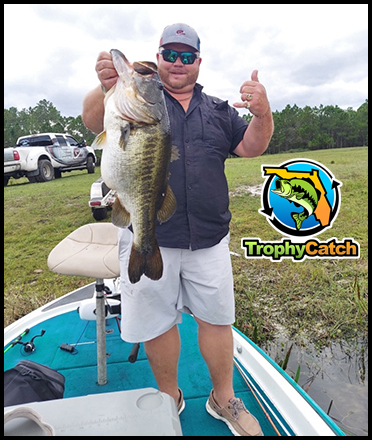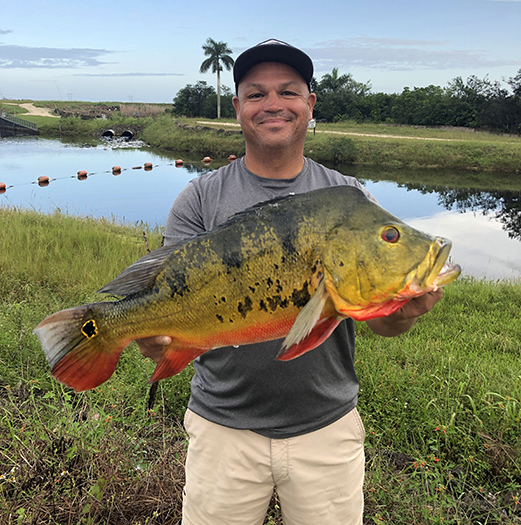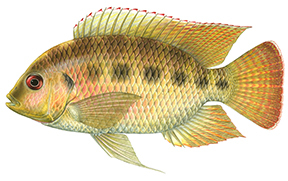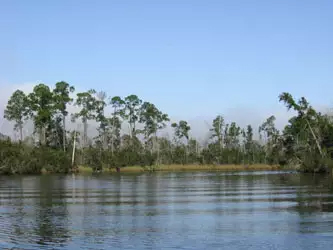 |
|
As we begin the New Year TrophyCatch Season 10 is well underway. So far for the current season the program has approved 92 Lunker Club catches (8 - 9.9 lbs.), 17 Trophy Club catches (10 - 12.9 lbs.), and a very early Hall of Fame catch (13+ lbs.) — see below! Complete totals since TrophyCatch's inception in 2012 include:
- 9,706 Lunker Club
- 2,412 Trophy Club
- 119 Hall of Fame
- 12,237 TOTAL approved submissions to date
One of the best things about these numbers is that each of these bass was released, to pass their genes on to the next generation as well as be a future angler's lifetime catch! As we achieve a decade of citizen-supported bass conservation we thank all our participants who have contributed this valuable data to guide FWC's bass research, as well as our conservation partners who have made the program fun and rewarding!
|
 |
Trenton Gilileo has gotten Season 10 off to a brisk start with an earlier-than-usual Hall of Fame catch, this 13 lbs. 6 oz. beauty caught-and-released October 30 in an unnamed Polk County pond.
The big event this past quarter was of course the Season 9 TrophyCatch Phoenix boat drawing during the Bobby Lane High School Cup at Camp Mack. Five finalists were randomly selected from TrophyCatch participants and James Bernard from Lee, Florida came away victorious. Although participating in TrophyCatch by documenting and submitting a trophy bass increases the chances of winning, anglers need only to register for TrophyCatch to be automatically included in the boat drawing. This was just the case for Bernard, who had not yet submitted a TrophyCatch bass. Partner Media1/WrapThis! was present to record this exciting event and you can watch the video here! (Note that a stand-in represented Bernard in the video.)
The next big event will be the TrophyCatch Season 9 Hall of Fame Ceremony which will be announced soon. However, follow us on Facebook/TrophyCatchFlorida for more HOF Ceremony details and exciting Season 10 promotions.

FWC fisheries biologists certified a new state record butterfly peacock bass weighing 9.11 pounds and measuring 23 5/16 inches long, caught by angler Felipe Prieto from Hialeah. Prieto was fishing this past October after work and caught the fish on live bait in a Broward County lake. This new catch supersedes the previous state record of 9.08 pounds that has stood for almost three decades since 1993.
Peacock bass are unique among freshwater fish as the only nonnative species to be legally established in Florida. The FWC stocked peacock bass in coastal southeast Florida canals in 1984 to help reduce the number of undesirable exotic fishes, especially spotted tilapia (see below). Subsequent study showed that this management effort has been very successful, with nonnative spotted tilapia making up over 75% of fish in the peacock bass diet. A side benefit of the stocking has been an additional fishery for Florida. Limited low temperature tolerance normally restricts butterfly peacocks to Broward and Miami-Dade counties but recent mild winters have allowed anglers as far north as Palm Beach County to enjoy catching this species. Native to South America, butterfly peacock bass have flourished in southeast Florida and FWC biologists have documented even larger fish. For more information, see the Peacock Bass brochure.
To properly certify a new freshwater Florida state record, an FWC biologist must identify the species and an FWC employee must witness its weighing on a certified scale. Anglers can check the current state records at BigCatchFlorida.com. Anglers should notify the nearest FWC Regional Office if they believe they have caught a record fish. Anglers are encouraged to be prepared to provide a photograph of the fish on a scale with the weight legible, for expediting the initial verification of the fish species and potential state record status.
|

Size: Grows to 13 inches and about 3 pounds; males grow larger with all fish over 10 inches typically being males. Note that spotted tilapia are not eligible for state record or Big Catch recognition.
Appearance: Light yellow to bronze with 6-9 bars or spots along side; stouter but similar body and mouth shape to native sunfishes; small ones tend to have bars that turn into spots in larger fish (see photo); some have reddish markings on the chin or throat area, especially when spawning; sometimes erroneously referred to as an 'Oscar.'
Range: First collected in 1974, it rapidly became the most abundant fish in the canal system of Miami-Dade County where it made up about 25% of the fishes by number and weight; now widespread south of Lake Okeechobee; so abundant that butterfly peacock was introduced to help control it. Native range is West Africa.
Habitat: Prefers slow-flowing canals, ponds, and lakes; common throughout south Florida; may be increasing in some areas, but not as abundant in Miami-Dade County as in 1980s.
Behavior: Unlike other tilapia in Florida, this tilapia is a substrate spawner that lays about 2,000 sticky eggs on hard, flat surfaces; both parents guard young aggressively until about one inch long; sexually mature at 7 inches; some observed spawning year around, but most spawning seems to occur in cooler months between November and March. The spotted tilapia is omnivorous, feeding on wide variety of food items, although most stomachs contain detritus, diatoms, algae, and sand indicating this tilapia, like most others, feed low on the food chain.
Sporting Quality: Commonly caught by cane-pole anglers, but not as aggressive as most native sunfishes; no bag or size limits, but must not be possessed alive (see note below). Live worms or doughballs are effective baits. Food quality is good.
Special Note: Possession and transport of live tilapia in Florida is illegal without a special permit (except blue tilapia); can only be possessed if dead, so anglers wanting to eat this fish should immediately place them on ice. Spotted tilapia are a prohibited species in Florida (68-5.003, Florida Administrative Code).
Fish graphic by Diane Rome Peebles
|
"I'm an avid bass angler and will be visiting south Florida soon. I would love to catch a peacock bass! What do I need to do?"

This question is one of the most frequent that the FWC's South Region Office receives from visiting anglers. The good news for bass anglers from anywhere in the country (or mid to north Florida for that matter) is that they already have all the skills needed for a successful peacock bass fishing trip. Some minor adjustments to the usual routine for putting a bucketmouth on the line will get a peacock to put a bend in your rod just as easily. Here are the main differences that traditional bass anglers should be aware of when deciding to try to put some peacock bass gold in the landing net:
|

1. Leave the plastic worms in the tackle box. This is probably the biggest difference between fishing for largemouth bass and peacock bass. The plastic worms and creature baits that are staples for largemouth bass just don't attract the attention of "peas" (as locals call peacock bass). Instead, break out your Rat-L-Traps, Rapala style minnow imitations, Tiny Torpedos, and curlytail or other jigs. Bright fire tiger and chartreuse color patterns are a dependable color whatever your choice of lure, with gold or silver good second choices for the minnow lures.
|

2. Scale it down: Peacock bass like smaller targets. While this may fly in the face of the "Big lure, big fish" mantra that most bass anglers are used to, butterfly peacocks are different in this regard. Northern anglers used to taking big trout on tiny flies may be able to relate to this concept better than their bass fishing brethren. Even the largest peacocks prefer smaller meals, with three inches being a good cutoff for maximum size. This applies equally to bait, and the ideal enticement for a peacock bass is a shiner in the three-inch range. One nice side benefit of this dietary preference is that small shiners are a lot easier on the wallet.
3. Speed it up: Peacock bass really like their food on the run. No matter what you're throwing, you'll usually want to retrieve your lure as fast as it will go without becoming unstable or rolling. Super-fast lightning strikes are a trademark of the peacock bass, and added to a fast retrieve make peacock bass fishing a thrilling adventure. One speed tactic for catching butterfly peacock during cooler months is to troll at a fast pace (5-8 mph) to cover a lot of water and when you locate a school, stop and cast into it.
|
 |
So if you're already a pretty good largemouth bass angler, then you're almost already a pretty good peacock bass angler — just add a south Florida fishing trip, and stir!
The only other thing you need to know is "Where?" For that, check the latest Metropolitan Southeast Florida Canals and Osborne-Ida Chain of Lakes Fishing Forecasts. Of course, largemouth bass inhabit the same Florida waters where you'll find peacocks, and all of these techniques are just as likely to put a black bass tugging on the end of your line. Peacock bass fishing is just one facet that makes Florida the crown jewel of the bass fishing world.
Size: 58 miles long (49 miles in Florida)
Location: Okaloosa through Santa Rosa County

Description: The Blackwater River, located in the FWC's Northwest Region in the Florida panhandle, is a 58-mile-long river of which 49 miles are in Florida. The river’s headwaters start in the Conecuh National Forest of Southern Alabama and enter Florida in Okaloosa County. The river flows from Okaloosa County through Santa Rosa County to Blackwater Bay, an arm of Pensacola Bay. The Blackwater’s sandy bottom, white beaches and large sandbars contrast with the tannic water that gives the river its name.
Access to the lower river is provided by boat ramps in Milton (Carpenters Park north of downtown Milton, just off Highway 191, and Russell Harbor Park, just north of Highway 90, on the east side of the river opposite downtown Milton), and in Bagdad (improved landing east of downtown Bagdad, off Highway 191).
With water temperature in the river getting below 60 degrees Fahrenheit, the striped bass bite is hot for big stripers! These large predators spend the summer months up the river in cold water refuges found in creeks but leave to feast on the large schools of bait that enter the lower river this time of year. These giants of the creek are often seen by FWC biologists during their sport fish population sampling.
|
 |
During the summer striped bass congregate in the cooler thermal refuges upriver. Cold weather makes these fish more accessible as they move to the lower river.
Anglers will have the best luck fishing a live menhaden or mullet on a fluorocarbon leader either under a large cork/balloon or free-lined. If this doesn’t work, try fishing a large swimbait in a white or mullet pattern or large curly-tailed soft plastic on a jig head with a good quality hook. The outstanding striped and hybrid bass fishery on the Blackwater River is a result of long-term stocking done annually by the FWC.
The striped bass, like this specimen documented by FWC biologists, offers Florida anglers one of the State's largest and most exciting freshwater targets.
To contact the Florida Freshwater Angler, email John Cimbaro. Fish illustrations by Duane Raver, Jr. and Diane Rome Peebles.
|